Tags
Anything and everything the Buddha did in his life has great significance to his followers, no mater how mundane, no mater how common. That’s all good and well – and understandable – but it’s not like he walked on water or something. Kicking back under a shady tree, for example, isn’t much to write home about. Even if you stay there for seven weeks. Attaining enlightenment while doing so, however, is noteworthy. Though by day five it’s not like you have the many other options to consider. Nonetheless, Buddhists are quite fond of the now famous reststop and attach a spiritual significance to the tree whose branches attracted the Buddha.
There is no record of what that tree was called prior to the Buddha’s visit. It was probably something simple like ‘that big tree over on that hill’. Or Big Tree for short. Since then it has been given an official name, Ficus religiosa, or for those who don’t speak Latin, Bodhi Tree. Which makes sense since bodhi is the sansrkit word for enlightenment. The one the Buddha plopped his ass under is (or was depending on who’s truth you adopt) located in Bodh Gaya, India, which also is quite fortuitous. Had it been located in Montreal instead, the Buddha might have been fined $147 for siting under it like Francois Gendron was earlier this year when he decided to do a bit of meditating in the shade under a large tree in Serge Garant Park himself. I guess in Canada the path to enlightenment includes learning to take Do Not Sit On The Grass signs seriously. Eh? Even if that sign is written in French.
Fortunately, the French never made great inroads into Thailand and both the bodhi tree and sitting on the grass have their place in Thai culture. Most wats have a bodhi tree growing somewhere on the grounds. A few are even famous in their own right. Wat Pho’s is supposedly a direct descendant from the original bodhi tree the Buddha honored with his extended bout of doing nothing. It is located in an easily accessible small raised garden adjacent to the building housing the Reclining Buddha. There’s one at Wat Benchamabophit, the Marble Wat, too. Given as a gift to King Chulalongkorn in the early 1900s, it’s located behind the temple’s cloister and is surrounded by a low stone wall used as the final resting place for the ashes of well-connected locals, possibly as a last ditch effort at enlightenment obtaining or at least as a noble attempt at influencing how karma will treat them in their next life (which, if you obtained enlightenment you no longer have go worry about).
The bodhi tree at Wat Bow Wow by Khaosan Road was planted by the King and is caged in an iron fence to protect it from the riff raff who meander over from Bangkok’s backpacker ghetto and think pulling a Francois Gendron might be a good idea. Not that you should read anything into a bodhi tree planted by the King getting higher security than the offspring of the one the Buddha blessed, mind you. But if you want to emulate either Francois or the Buddha, Wat Pho might be the better choice.
Bodhi trees that stem (see what I did there?) from the original, or claim to, are as numerous as are Kardashians though admittedly are of slightly more use even though the average Kardashian ass casts almost an equal amount of shade. The roots of some (yup, I did it again) can be directly traced to the original in Bodh Gaya. HRM King Bhumibol just got another one in May from Indian Prime Minister Manmohan Singh during his official State visit. Saplings from the original bodhi tree are a popular gift from the Indian government due to their religious significance. Or because they are a cheap gift.
Jaya Sri Maha Bodhi is one of the more renown bodhi trees that comes from the original, though it grows in Sri Lanaka, not Thailand. The only reason I mention it is that a sapling from that tree was given as a gift to Mary Foster back in 1913, who upon her death donated her house and garden to the people of Honolulu, which became the Foster Botanical Garden. Which while of mild interest to those with a connection to the islands, brings back some great memories for me ‘cuz I spent many memorable hours having car sex in the Garden’s small shady parking lot with a little hot bodied fuck buddy of mine who liked to sneak in a quickie during his lunch break from work. And the ass on that boy, which put the entire Kardashian clan to shame, was a religious experience in its own right. Not to mention it kinda mimicked the heart shape of a bodhi tree leaf. Just in case you thought that pleasant sexual digression had little to do with the subject at hand.
Back in Thailand, significant bodhi trees at temples often sport a number of parsarm si – strips of a gauzy three-colored cloth – which comes from an ancient tradition of nature worship that honors the tree’s spirits. Almost as popular are metallic, fake bodhi trees, which are a vehicle for merit making, which comes from an ancient tradition of money worship that honors the wat’s need for baht. These are often erected when a wat is constructing a new building; for a donation of just a few baht you can sign your name on a leaf and then hang it on the tree yourself. Which ain’t a bad interactive touri activity whether you actually gain any merit or not. Similarly, at Doi Suthep in Chiang Mai, you can ‘purchase’ small brass bells whose clappers have a metal bodhi leaf attached that you can also sign before hanging the bell pretty much wherever you want at the wat. Whether you consider that merit making or institutionalized graffiti, it’s cheaper than the fine you’d get charged for sitting under a tree in Canada.
Related Posts You Might Enjoy:

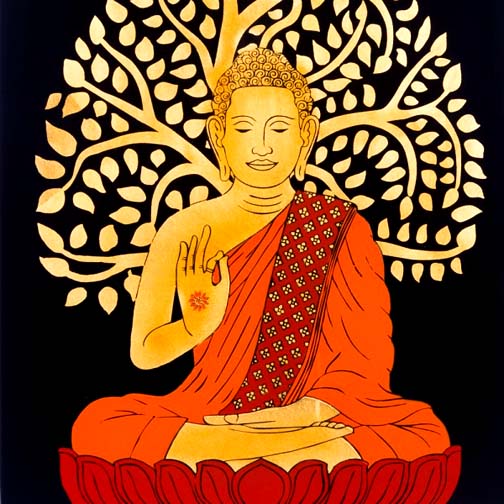

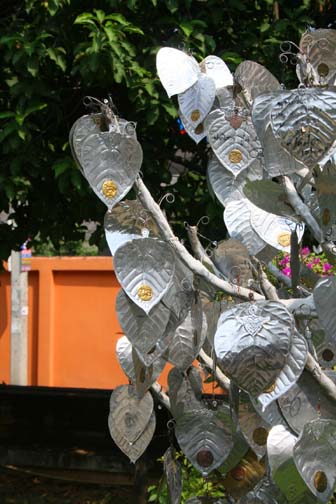
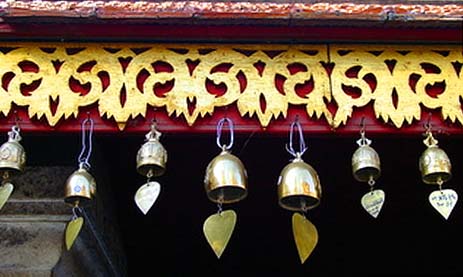
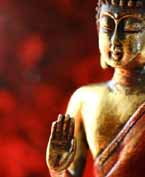

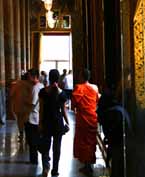
A an “Enlightened One,” also, I can see that apparently Buddha’s girlfriend was Rosey Palm!
Oh leaf me alone.